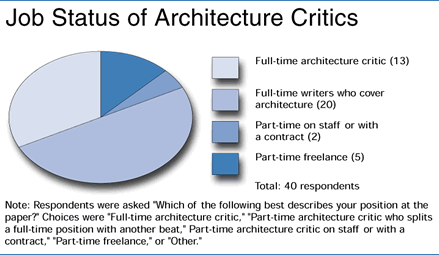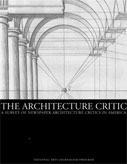
Study calls for more space, greater resources for architecture criticism

Associate Editor
Architecture is the "smallest niche of the smallest beat of the smallest department at most newspapers," according to a study released last month by the National Arts Journalism Program at Columbia University.
The report, "The Architecture Critic, A Survey of Newspaper Architecture Critics in America," examines how 40 writers, who identified themselves, or whose editors marked them as architecture critics, view their roles at their newspapers, their relationships with the profession of architects and builders, and their theoretical influences and aesthetic preferences.
The survey laments the lack of full-time architecture critics and the paucity of architecture critics in general. It calls for a "further investment into architecture criticism, especially in medium-size newspapers and in smaller communities, where some of the most dramatic changes in the built environment are currently taking shape."
Drawing its pool of critics from about 140 newspapers with circulation exceeding 75,000 as of June 30, 1999, the 34-page study found that fewer than 45 of the dailies have architecture critics. Several major cities, including Houston, Miami, and Detroit, do not have regular architecture features.

Only a third of the 40 responding journalists pursue architecture criticism full-time and the remaining writers are part-time freelancers or staff writers who cover other subjects too. The study did not include "home design, real estate or urban design writers, nor . . . journalists whose architecture writing focused exclusively on news features and profiles."
The study is important in the way it calls attention to the impact architecture writers have on the public's education about buildings and the need for newspapers to "follow their obligations to cover architecture in a critical way," said Blair Kamin, the architecture critic for the Chicago Tribune. It also underscores the need for more public discourse about architecture, Kamin said.
"Most architecture critics are bringing important issues before the public," matters that have an impact on the public realm and quality of life, Kamin said. "The report's conclusions are excellent" and should be "taken to heart" by newspaper editors and publishers, he said.

For the most part, the survey said, architecture is considered part of the arts beat and most stories on architecture appear in the arts section. Critics say they have autonomy in what they choose to cover, and no writers said they feel pressure to write positively about a subject to "please advertisers or people connected with the newspaper." The critics may receive this latitude as a result of their "significant" experience: four out of five respondents have written about architecture for more than five years, and two-thirds more than 10 years. Thirty-three have held other newspaper jobs.
Only 25 percent have degrees specific to the field of architecture.
To capture the critics' aesthetic tastes, the survey asked them to rate buildings, architects, and architecture writers and thinkers. The three highest-rated works of architecture were the Brooklyn Bridge, Grand Central Station, and the Chrysler Building. Three favorite recent buildings include Frank Gehry's Bilbao Guggenheim, Richard Meier's Getty Center, and James Stewart Polshek's Center for Earth and Space. In addition, in a different question, the architects expressed regret that the field pays too much attention to the work of popular artists.
The critics' opinions on critical writing "suggest a focus on urbanism as strong or stronger than the focus on individual building." They also center their work on projects and issues that are highly visible to the public and, as one writer phrased it, "attempt to involve the public about projects underway." The report notes that others felt a responsibility to "raise hell" or "engage or inflame if need be."
Kamin said the survey "put meat on a vague idea" and supplies numbers that make it indisputable that there needs to be more focus on devoting space and resources to architecture criticism. He continued that the question now is "Who takes the next step?" and suggested that the architecture community, including the AIA, should continue to work to educate the public at large about the importance of architecture and to spur action that produces "more writing, more thought, and better buildings."
Among other key findings:
• More than 75 percent of critics said their writing had an impact
on architecture in their region, but more than half said architects and
developers do not consider their opinions when designing new projects
• Nearly all critics believe their readers care about the built environment,
and most feel those readers have a basic understanding of architecture;
three fourths of critics seem themselves as educators
• Male architecture critics outnumber their female peers almost three
to one
• More than half the critics believe their newspapers would not make
it a priority to replace them if they left their jobs.
"This survey isn't the last word on architectural criticism, but it's a good first step," said NAJP Deputy Director András Szántó, in a press release. Szántó directed the research and co-authored the study.
In the most recent issue of Architectural Record, Robert Ivy, FAIA, noted of the study, "When it succeeds, criticism informs debate and educates, clarifies the issues and states a position, allowing us to make informed decisions, to be wiser consumers and more ardent and rational proponents for worthwhile efforts."
Perhaps editors and publishers should pay more attention to critics and, as Kamin suggested, find ways to get architecture in the public discourse.
"Together, the full-timers write for newspapers with a combined circulation of more than six million. If these critics praise or condemn a project, there are few places readers would encounter a second opinion," the report's authors pointed out.
Copyright 2001 The American Institute of Architects. All rights reserved.
![]()
|
Click here for the full text of the report, including the list of participating newspapers and the research questions. |
|
 |
|